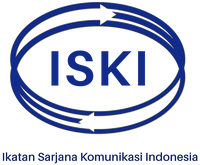Reformasi Birokrasi Pemerintah dan Penerapan Excellence Theory
DOI:
https://doi.org/10.31315/jik.v10i1.86Keywords:
excellence, knowledge core, shared expectation, participative culture, koalisi dominan, communicator.Abstract
Excellence theory yang dikembangkan oleh James E. Grunig menyebutkan bahwa organisasi yang menerapkan excellence communication memiliki tiga komponen (sphere) yang saling berkaitan satu sama lain, yaitu knowledge core, shared expectation, dan participative culture. Studi ini bertujuan untuk melihat sejauhmana excellence theory dapat diterapkan pada lembaga pemerintah sebagai badan publik yang hingga kini sedang menjalani proses reformasi birokrasi. Penelitian dilakukan di Biro Humas Badan Pemeriksa Keuangan Republik Indonesia (BPK-RI), dengan menggunakan pendekatan deskriptif kualitatif. Hasil penelitian menunjukkan bahwa, pada organisasi yang belum sepenuhnya menjalankan budaya partisipatif, khususnya antara pimpinan BPK-RI sebagai koalisi dominan dengan Biro Humas sebagai komunikator, maka penerapan excellence theory tidak optimal. Hal ini karena, budaya partisipatif (participative culture) adalah dasar dari adanya hubungan yang sinergis antara harapan koalisi dominan dengan harapan komunikator (shared expectation), yang pada gilirannya juga memengaruhi bagaimana komunikator mengimplementasikan pengetahuan (knowledge core) dalam menjalankan tugasnya.References
Akses Informasi Publik di PN Makassar Buruk, www.makassarterkini .com
Argenti, P.A., & Forman, J., 2002, The Power of Corporate Communication, Crafting the Voice and Image of Your Business, Mc Graw Hill.
Austin, E.W., & Pingkleton, B.E., 2006, Strategic Public Relations Management, Planning and Managing Effective Communication Programs, (edisi ke-2), Laurence Erlbaum Association, Inc., New Jersey.
BPK Mendorong Tercapainya Transparansi dan Akuntabilitas Pengelolaan Keuangan Negara http://www.bpk.go.id/ web. Conrad, C., & Poole, M.S., 2005, Strategic Organitational Communication In a Global Economy, (6th edition) Thomson, USA.
Daniels, T.D., Papa, M.J.,and Spiner, B.K.,1997, Perspective on Organizational Communication. Mc Graw Hill.
Daymon, C., & Holloway I., 2002, Qualitative Research Methods in Public Relations and Marketing Communications, Routledge, London.
Dozier, D., Grunig, J.E., & Grunig, L.A., 1995, Manager Guide to Excellence in Public Relations and Communication Management, Lawrence Erlbaum Associates, New Jersey.
Efendy, Muh. Taufik, 2010, Pengaruh Kompetensi, Independensi dan Motivasi terhadap Kualitas Audit Aparat Inspektorat dalam Pengawasan Keuangan Daerah (Studi Empiris pada Pemerintah Kota Gorontalo), Universitas Diponegoro, Semarang.
Fajrin, Hadita, 2010, Studi Communication Excellence dalam Divisi Hubungan Masyarakat Lembaga Negara di Indonesia, Universitas Indonesia, Depok. Grunig, J.E.,1995, Excellence in Public Relations and Communication Management, Lawrence Erlbaum Associates, New Jersey.
Grunig, J., & Grunig L., 2000, Public Relations in Strategic Management andStrategic Management of Public Relations: Theory and Evidence from the IABC Excellence project [Monograph], Journalism Studies, volume 1.
Grunig, J.E.,Grunig, Larissa A., 2010, Public Relations Excellence 2010, PRSA International Conference Sunday, October, 2010,Washington DC.
Grunig, J.E., and Hunt, T., 1984, Managing Public Relations, Holt, Rinehart, Winston, New York.
Grunig, James E. The Public Relations Excellence Theory, http://kdpaine.blogs.com/
Hon, Linda Childers and Grunig, James E., 1999, Guidelines for Measuring Relationship in Public Relations, Institute of Public Relations, http://www.instituteforpr.org/ topics/measuring-relationships.
Kent, Michael L and Taylor, Maureen, 2002, “Toward a Dialogic Theory of Public Relations”, Public Relations Review, volume 28, Februari 2002.
Moleong, L.J., 2006, Metodologi Penelitian Kualitatif, (edisi revisi), PT Remaja Rosdakarya, Bandung.
Namora, Yosye Ajidan, 2011, Independensi Lembaga BPK dalam Proses Pemeriksaan untuk Mewujudkan Transparansi dan Akuntabilitas Keuangan Negara (Studi terhadap BPK Lampung).
Neuman, W.L., 2003, Social Research Methods: Qualitative and Quantitative Approaches. (5th edition), A and B, USA.
Patton, M., 1990, Qualitative Evaluation and Research Methods, Sage, Newbury Park, CA.
Patton, M. Q., 1991, Metode Evaluasi Kualitatif (Budi Puspo Priyadi, Penerjemah), Pustaka Pelajar, Yogyakarta. Publik Masih Sulit Akses Informasi, http:// www.jurnas.com.
Purnomo, Eko Priyo, 2010, Development of Local Institutions towards on Participation and Communication Model in United Kingdom, Jurnal Ilmu Komunikasi, Volume 8, Nomor 3, September-Desember 2010. Program Studi Ilmu Komunikasi FISIP UPN”Veteran”Yogyakarta.
Selayang Pandang Reformasi Birokrasi BPKRI, Oktober 10, 2009, http://www.bpk. go.id/ Seitel, F. P., 2010, Practice of Public Relations, (8th edition), Prentice Hall.
Siapkah Badan Publik Kendal Menghadapi Berlakunya Keterbukaan, http://www. sekorakyat.org
Susanto, Eko Harry, 2011, Dinamika Media Massa Lokal dalam Membangun Demokratisasi di Daerah”, Jurnal Ilmu Komunikasi, Volume 9, Nomor 2, Mei-Agustus 2011, Program Studi Ilmu Komunikasi FISIP UPN”Veteran”Yogyakarta.
Struktur Organisasi Badan Pemeriksa Keuangan RI. http://www.bpk.go.id.
Warga Sintang Sulit Akses Informasi Publik, www.kalimantan-news.com.
Wilcox, Dennis L and Cameron, Glen T, 2009, Public Relations: Strategies and Tactics, Ninth edition, Pearson Education, Inc, United States of America.
Toth, Elizabeth L., 2007, The Future of Excellence in Public Relations Management; Challenge for the Next Generation, Lawrence L Erlbaum Associates, New Jersey.
Undang Undang No. 14 tahun 2008, tentang Keterbukaan Informasi Publik.
Downloads
Published
Issue
Section
License
Authors who publish articles in this journal agree to the following terms:
- Copyright remains with the author and gives rights to the Jurnal Ilmu Komunikasi as the priority to publish the article with an Creative Commons Atribusi 4.0 Internasional License, which allows the article to be shared with acknowledgment of the author of the article and this journal as the place of publication.
- Authors can distribute the publication of their articles on a non-exclusive basis (for example: on university repositories or books) with notification or acknowledgment of publication in the journal Option
- Authors are allowed to post their work online (for example: on personal websites or in university repositories) before and after the submission process (see The Effect of Open Access)
Jurnal Ilmu Komunikasi is licensed under a Creative Commons Atribusi 4.0 Internasional License.









